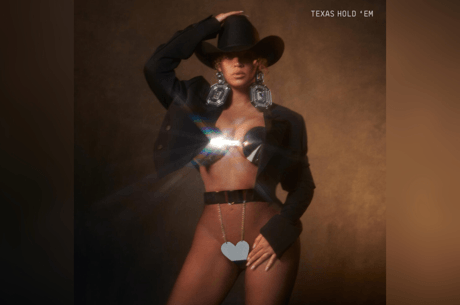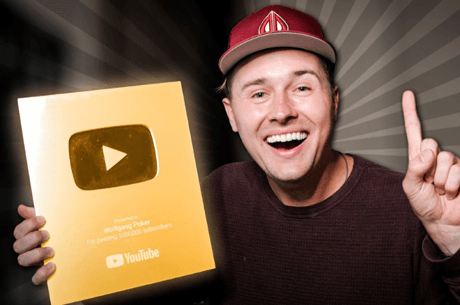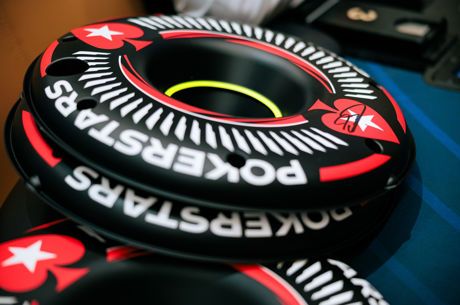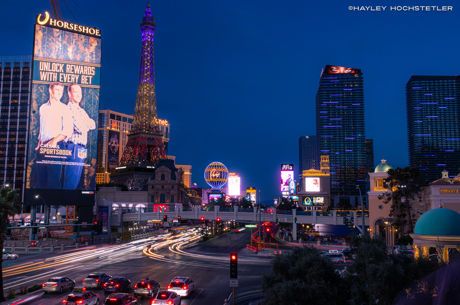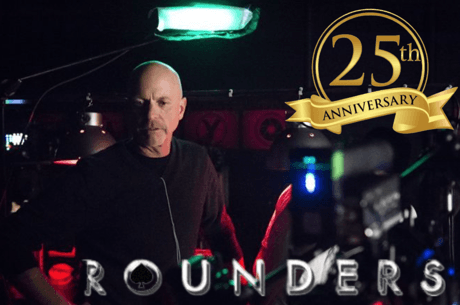Poker & Pop Culture: Mainstream America Watching Amarillo Slim

A little over two weeks after Chris Moneymaker won the 2003 World Series of Poker Main Event, the Tennessee accountant appeared as a guest on the June 10, 2003 episode of Late Night with David Letterman.
At the time, Moneymaker wasn't especially enthusiastic about being thrust into the limelight, and would later describe getting over his initial trepidation about doing such publicity as the "biggest challenge" he faced following his WSOP victory. As we know, Moneymaker would go on to handle the role of "poker ambassador" especially well thereafter, playing an important role in that regard (along with others) during those initial years of the "poker boom."
Few remember or saw that Late Night segment, and it doesn't appear to have survived as a clip online. In truth, that appearance didn't create too much of a stir, especially when compared to the later airing of the WSOP Main Event on ESPN, shown in seven parts during July and August.
A little over three decades earlier, another WSOP Main Event champion appeared as a guest on a late night talk show, the first ever to do so. And while most of us remember (and/or were part of) the "Moneymaker Effect," fewer might recall or appreciate the signficance of that earlier round of mainstream publicity afforded poker — the one made by 1972 champ Thomas Austin "Amarillo Slim" Preston.
The 1972 WSOP; or, Pickin' Slim
"They knew they couldn't get any publicity out of it if Doyle won it… and that's not putting Doyle down... Doyle just wasn't a talker in those days. And Puggy wasn't a good choice because about half the people he screwed over the years were bound to say a few things. So I was the pick for winning it."
So explained "Amarillo Slim" Preston to author Des Wilson in the latter's Ghosts at the Table (2008) when commenting on the finale of the 1972 World Series of Poker Main Event. Wilson's book delves into various mysteries surrounding poker's long, colorful history, including the story of that year's Main Event, the truth of which has been contested over the years as energetically as some WSOP final tables.
In just its third year, the Series at Binion's Horseshoe was still a modest affair, with a small field of entrants who attracted only scant coverage by various (mostly local) media outlets. Only eight professionals entered the Main Event that year, each of whom ponied up the then-$5,000 entry fee.
Primarily to drum up additional interest in the WSOP and in the Horseshoe, Benny Binion added an extra $5,000 per player, making it $80,000 total for the one finishing first in the winner-take-all format. That may not seem much compared to today's super high roller prize pools, but inflation calculators tell us $80K in 1972 was the equivalent of about $470K today — a big enough prize to help the story of the that year's WSOP make its way outside of Glitter Gulch.
After one day of play, four of the original eight remained — Doyle Brunson, Puggy Pearson, Jack Straus and Preston. A few hours into Day 2, Straus was eliminated in fourth. That's when the remaining players began talking.

What they discussed is a matter of great debate, though by most accounts the conversation involved both Pearson and Brunson sharing reservations about the potentially negative publicity that being crowned the world champion of poker might bring to the winner — not to mention the extra aggravation of earning IRS agents' notice. We know, at least, Brunson felt that way. Declaring himself the victim of a stomach ailment, he was allowed to cash out his remaining chips, an amount Wilson says was $40,000, although other accounts put closer to $20,000.
Pearson and Preston were left to battle it out for the rest, with Preston eventually taking the last of Pearson's stack when his king-jack bested Pearson's pocket sixes. While Brunson and others have insisted that Pearson legitimately tried to win the bracelet, Preston himself has suggested — in Wilson's book and elsewhere — that he had perhaps been "picked" to win by Binion and others interested in increasing the profile of the WSOP.
Whatever actually happened, Preston was certainly more than willing to take on the challenge of becoming a kind of unofficial spokesperson for poker. In a memoir later co-written with Greg Dinkin, Preston would claim Benny Binion had essentially anointed him as such. There Preston notes that Binion, with reference to poker's lowly status in mainstream culture, told him "Slim... you're the only sonofabitch that can get this up out of the dirt."
In Play Poker to Win (1973), a book of strategy and storytelling Preston produced shortly after his win, he describes himself wandering about outside the Horseshoe a couple of hours after having claimed the Main Event title, a reporter in tow.
"I'm looking for a game — any game at all," he purportedly cries out into the night. "Seems like a feller should be able to get a game like that — something interesting, you know — in a town like this."
He'd find something interesting, all right. A different kind of game, as it were.
Heeeeeeeeere's Johnny!
Within a month of his WSOP triumph, Preston was invited to appear on The Tonight Show with Johnny Carson on June 16, 1972.
The show had only just relocated from New York to Burbank, California the month before, where it would be produced for the remainder of Carson's tenure as host and afterwards when Jay Leno took over in 1992. Preston took the stage that night with Johnny along with Steve Allen (a former Tonight Show host), comedian Bill Dana, actress Jane Meadows, Latin jazz percussionist Willie Bobo and pop singer Kenny Rankin.
Robin Williams once suggested that "being on Johnny Carson was like being on Centre Court at Wimbledon." The analogy is apt, particularly when one refers to the show's pre-cable television heyday when its influence as the single most-watched late night talk show was at its height.
After taking over The Tonight Show in 1962, Carson had increased the show's audience considerably, thanks largely to his amiable personality, his quick-wittedness and his special capacity for steering clear of the spotlight to let his guests shine. It was a perfect fit for the gregarious Preston. Indeed, when it came to his showing on Carson — to borrow a term from both tennis and poker — Amarillo Slim was aces.

In Total Poker (1977), David Spanier spends a chapter focusing on 1972 Main Event runner-up Pearson, telling the story of Puggy's triumph in the Main Event the following year. There Spanier contrasts Pearson with Preston, suggesting Slim was "much more a poker player's stereotype." Preston certainly possessed a showman's flair like few other poker players of the day. However, it was his ability to slip into that role — that stereotype — that likely played so well to those tuning in across the country to watch Johnny.
In All In: The (Almost) Entirely True Story of the World Series of Poker (2005), Jonathan Grotenstein and Storms Reback describe Preston's "special fondness for boldly colored suits and custom boots" and shirts with "emerald buttons, the louder ones dollar gold pieces," topped off with his trademark, wide-brimmed, ten-gallon Stetson.
The look fit well with the image of Old West gamblers like Wild Bill Hickok and famous card sharps like George Devol, with Preston stepping out of the 19th century to bring poker into 1970s living rooms. And hearing him speak, one soon realized it wasn't just a look he was cultivating — it was a fully-formed persona.
Though originally from Arkansas, Preston's family had moved to Texas when he was a child, and throughout his adult life he'd consistently present himself as the Texas road gambler, "fading the white line" while always on the lookout for a good hustle. As a result, Preston was a perfect liaison between America's heartland and Vegas glitz and glitter.
Preston's homespun one-liners and anecdotes about his various prop bets won him numerous invitations back to The Tonight Show. He'd return to the show again that August, and ten more times after that. Preston would later claim that Carson became so comfortable with him he began inviting him on every time Bob Hope was a guest "so Mr. Hope wouldn't make him so darn nervous."
Preston had a history with Hope, in fact. After being discharged from the Navy following WWII, Preston had participated in a Special Services tour in Europe to entertain troops. An accomplished billiards player, Preston performed pool tricks for the servicemen, and had met Hope during that period.
Suffice it to say, Preston found the couch on The Tonight Show set plenty comfortable, and during the early 1970s it was from that seat Preston more than anyone else successfully carried poker and the WSOP to the masses.
Poker's "Goodwill Ambassador"
The Amarillo Slim publicity tour would continue beyond The Tonight Show. Preston was profiled on 60 Minutes, and would appear as a guest on Good Morning America as well as on several game shows, including To Tell the Truth, What's My Line? and I've Got a Secret.
"Everyone said that I was the Muhammad Ali of poker," Preston would remark on a later documentary. "That I was the goodwill ambassador [for the game]."
Preston addressed the National Press Club on two occasions, and was even invited to speak before the U.S. Senate. He was a guest on The Mike Douglas Show, the most popular daytime talk show of the era. He also once appeared with Benny Binion on Tom Snyder's The Tomorrow Show that followed Carson on NBC on an episode in which the pair were featured for the entire hour-long program.
"After a while these shows became kinda routine," says Preston in his memoir. "But I kept making appearances, because I knew it'd be good for Benny and the World Series of Poker, and, as it turned out, it was even better for old Slim." Preston would do numerous commercials and even took a turn playing himself (or a larger-than-life version, you might say) in Robert Altman's classic 1974 gambling film California Split.
Binion's decision to increase the Main Event prize pool in 1972 and Preston coming away the winner did have the intended effect of increasing the WSOP's profile. According to Reback and Grotenstein, a whopping 7,000 newspaper and magazine articles would be written about the 1973 WSOP.
One of those articles appeared in the May 28, 1973 issue of Time, a profile of Preston titled "Slim's Good Life." Aside from sharing the usual tales about Preston's prop bets, the article introduced Time readers to the structure of the WSOP Main Event, explained how Texas hold'em was played and even briefly touched on certain poker-related concepts (such as identifying tells) that began to suggest the skill set needed to succeed in poker.

CBS would come around to cover the Series the following year, filming a documentary hosted by Jimmy "The Greek" Snyder. While Preston wouldn't repeat as champion (Pearson won), he nonetheless was the star for the first half of it (available to ).
A few years later Preston was still a central part of the show when the 1979 WSOP Main Event was again featured on CBS, shown at the beginning riding on horseback down Fremont Street as though galloping to Binion's straight from an Old West saloon. (You can , too.)
It was an image that for mainstream audiences connected poker's history and legacy to a modern version of the game. And it set the stage for its further growth and the "ambassador"-like efforts of Moneymaker and others that later followed.
From the forthcoming "Poker & Pop Culture: Telling the Story of America's Favorite Card Game." Martin Harris teaches a course in "Poker in American Film and Culture" in the American Studies program at UNC-Charlotte.
Photos: "," UNLV Special Collections on the World Series of Poker, ; "" (adapted), Divadrerhuf, ; "Binion's Horseshoe," WSOP; stills from "The Michael Douglas Show" and the "1979 World Series of Poker."




